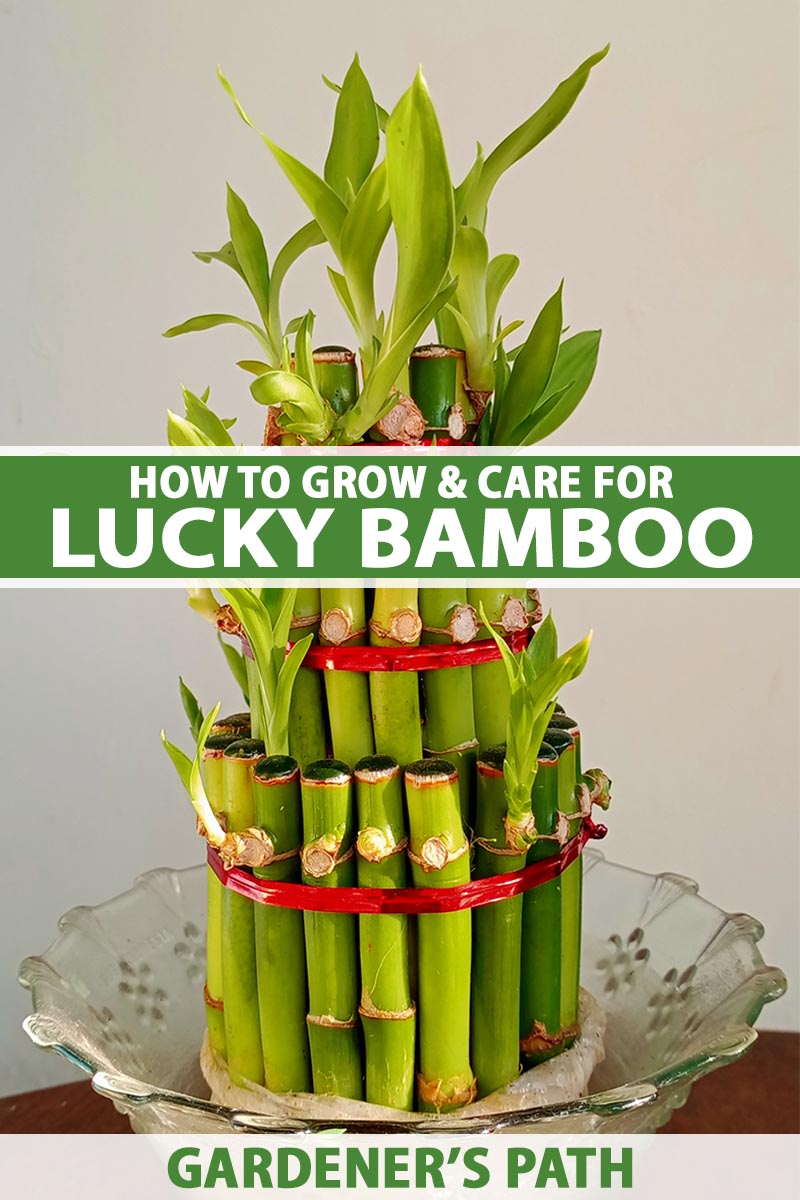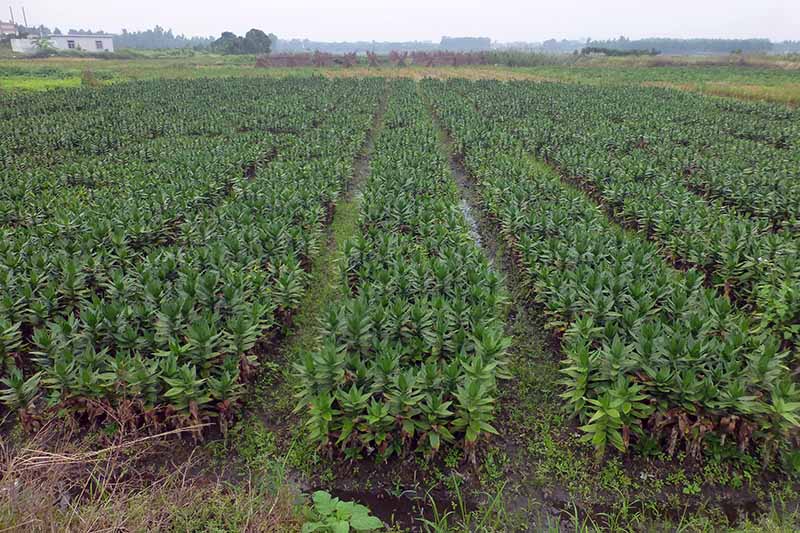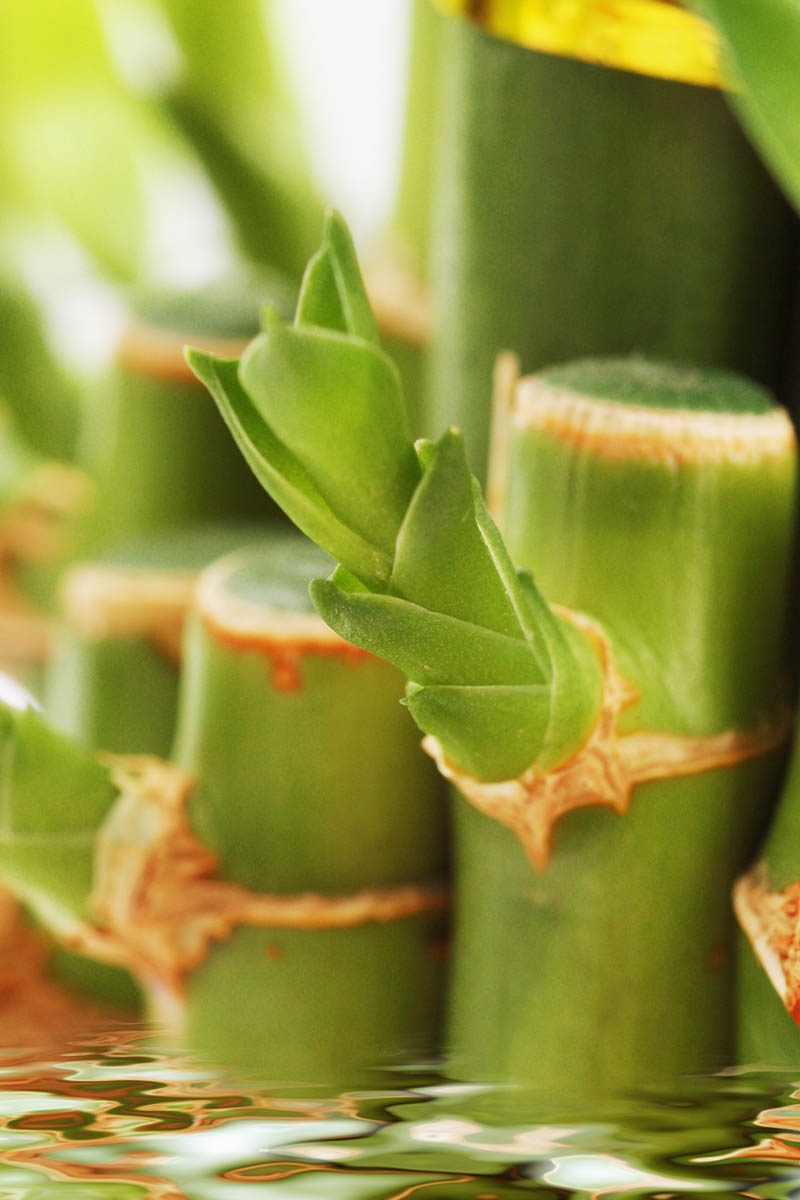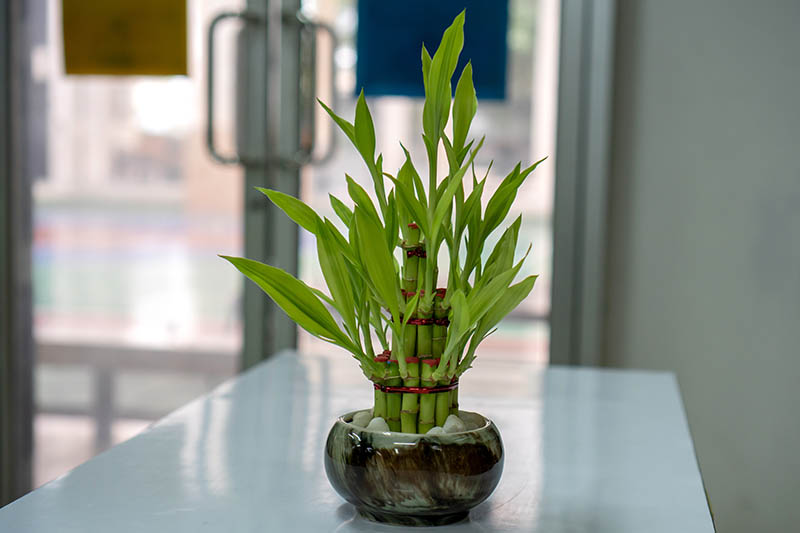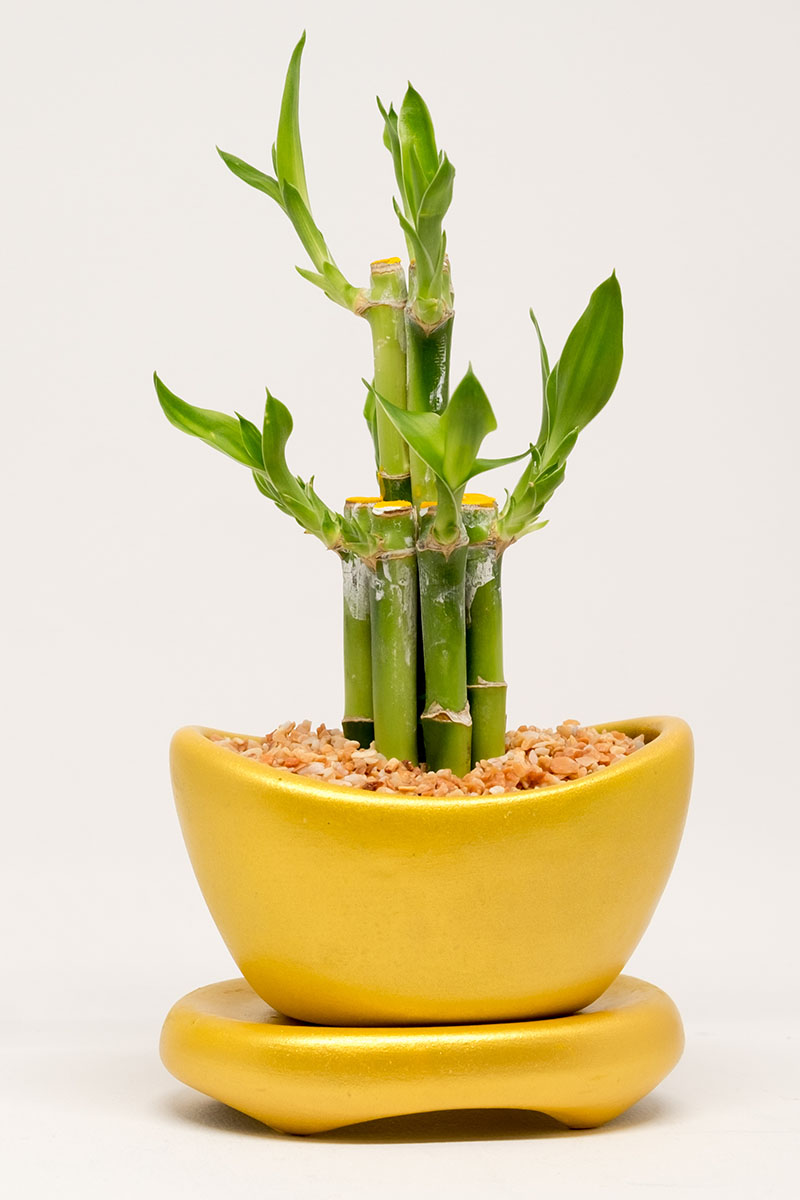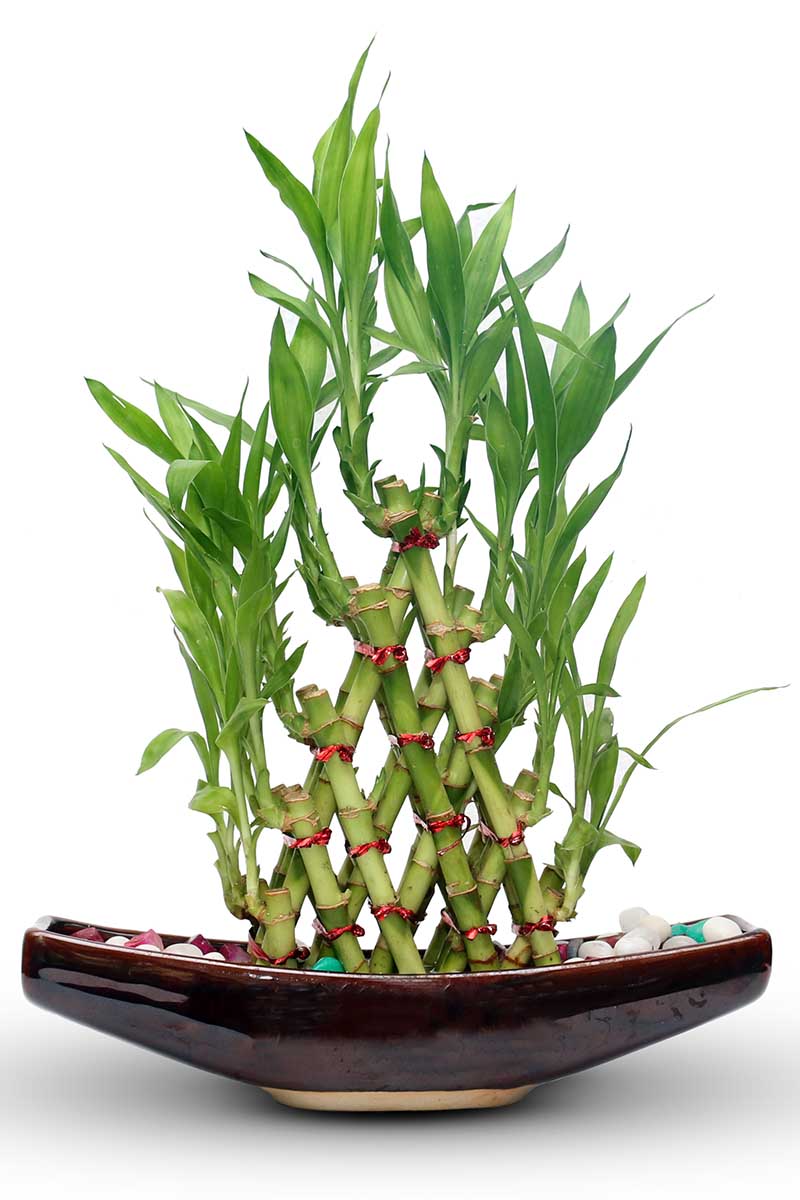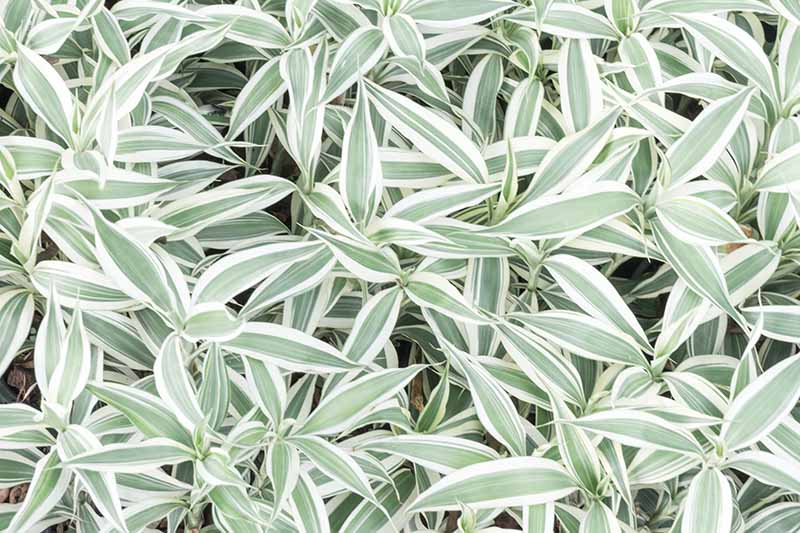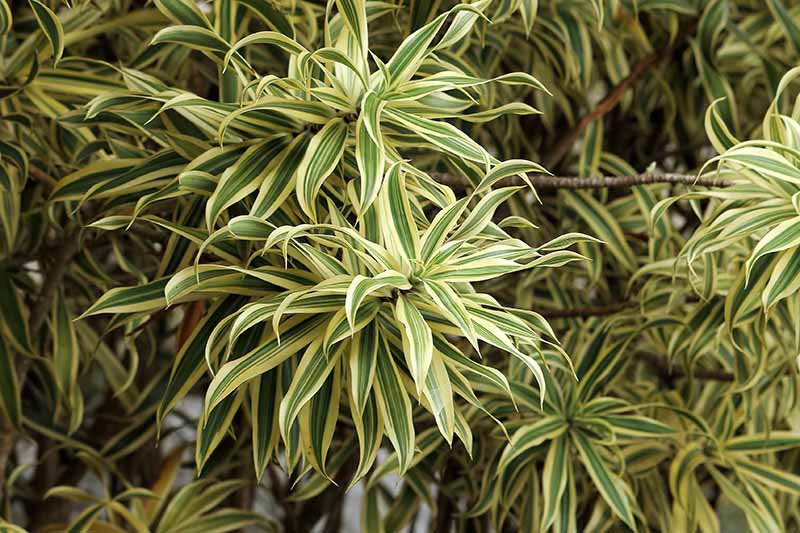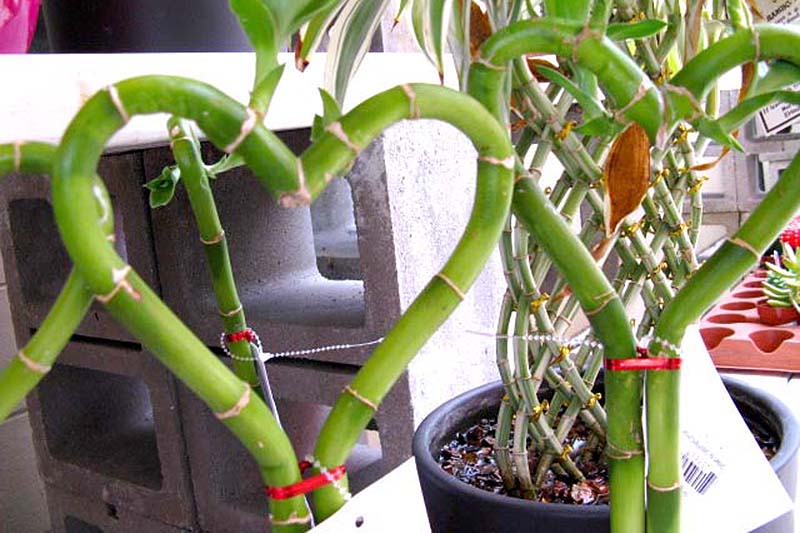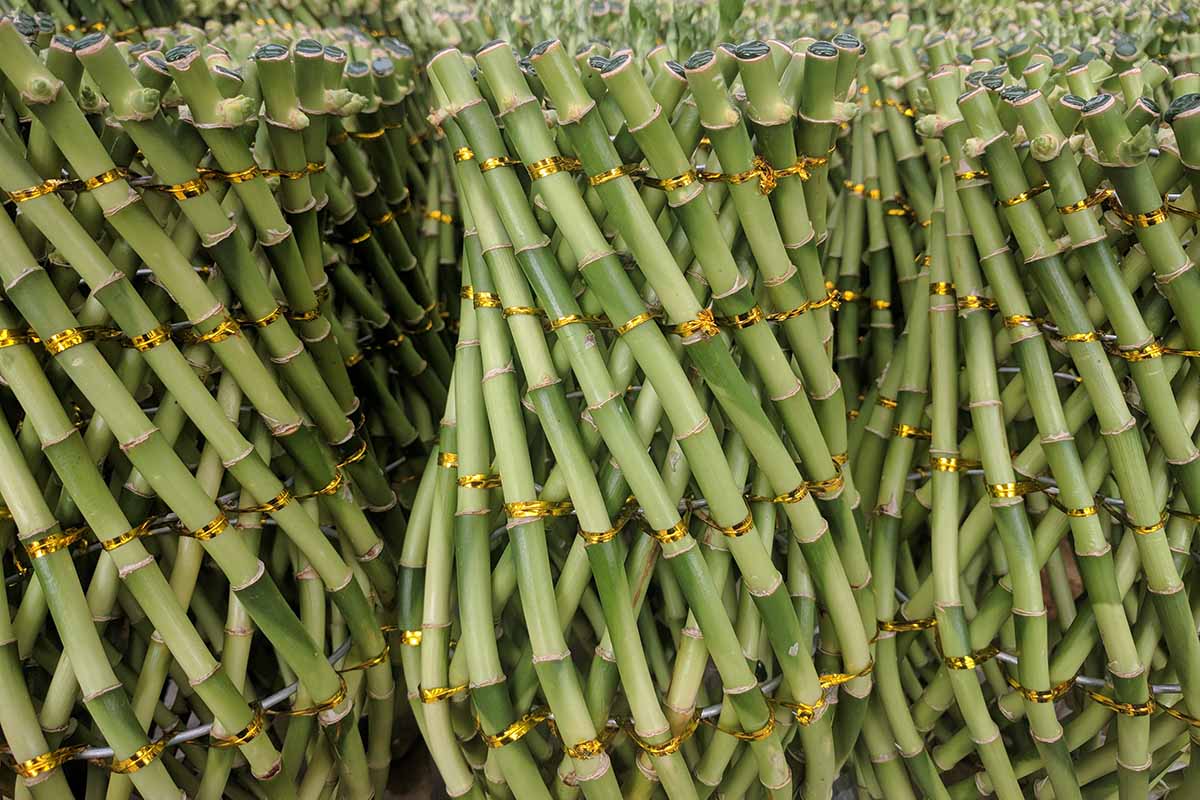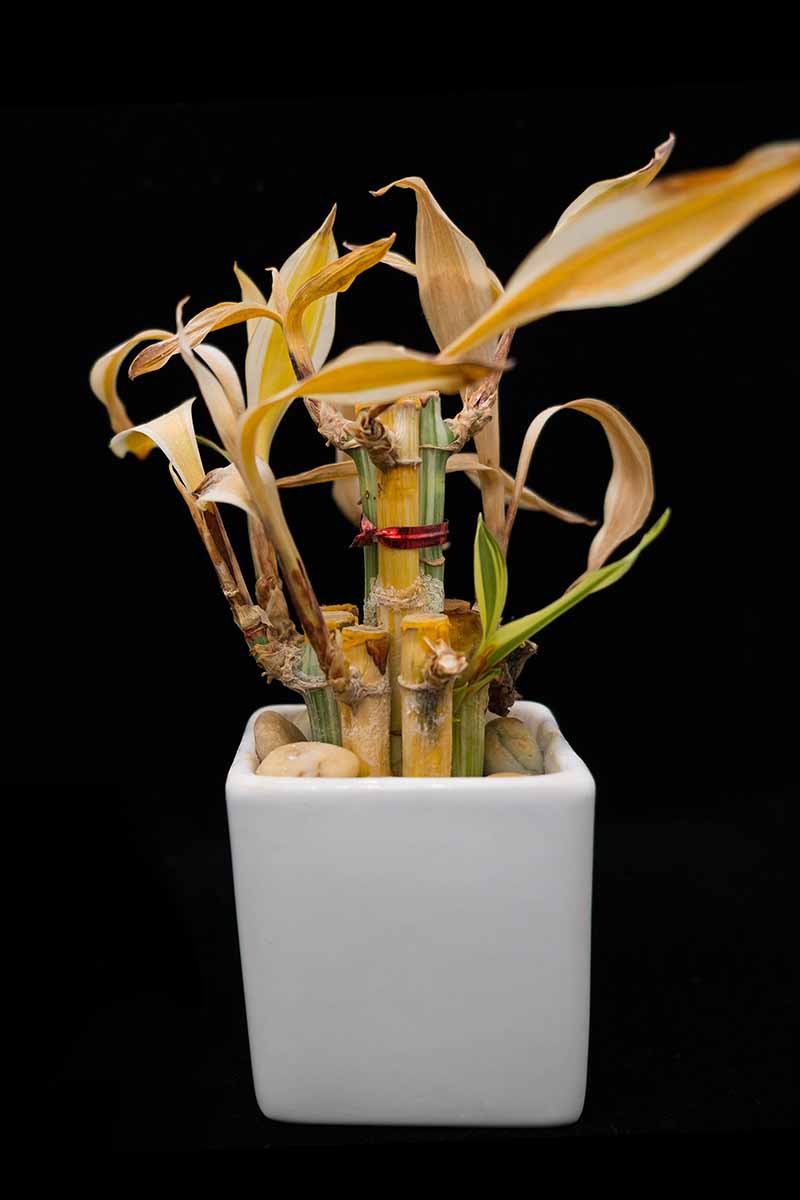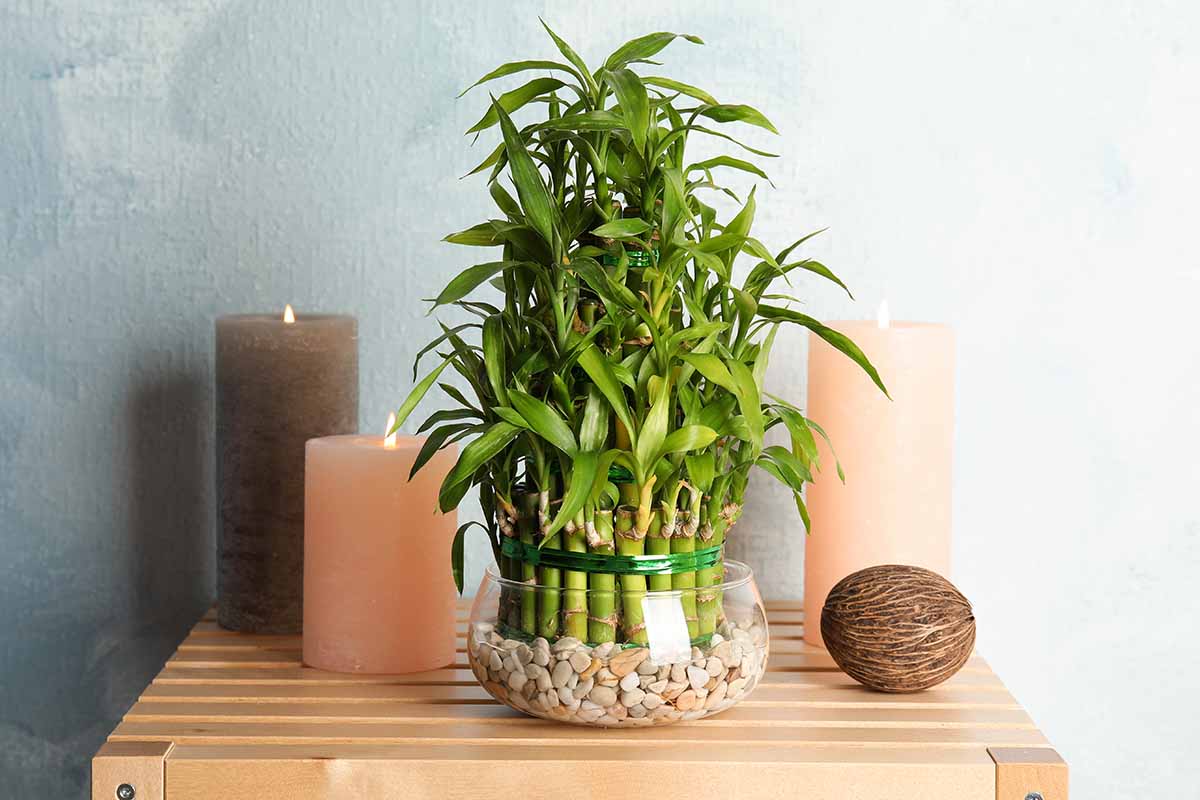They’re called “lucky bamboo,” and despite their ubiquitous presence, they are anything but common. Lucky bamboo, Dracaena sanderiana, is widely cultivated as a houseplant that can grow in both water and soil. The name also applies to a different species, D. brauneii, which has denser foliage at its base. The two types are often sold interchangeably, with D. sanderiana being most prevalent. We link to vendors to help you find relevant products. If you buy from one of our links, we may earn a commission. Instead, they are in the Asparagaceae family that also includes agave, asparagus, and yucca. As you read this article, you’ll develop a working knowledge of lucky bamboo’s cultural symbolism, and learn to grow and care for your own. Let’s start with a little background.
Cultivation and History
Also known as Chinese water bamboo and the fortune or ribbon plant, this bamboo-like species is a large commercial crop in Asia, but is native to the African Republic of Cameroon. Named at the turn of the 20th century for German-English botanist Henry Sander, D. sanderiana thrives outdoors in part-shade in USDA Hardiness Zones 10 and 11, where it achieves a mature stature of three to five feet tall and wide. Unlike true bamboo, D. sanderiana also makes an easy-care indoor plant in bright, indirect sunlight, where the effects of indoor cultivation and ornamental pruning limit its growth to more modest table-top dimensions of one to three feet tall, and one to two feet wide. The leaves are lance-shaped and may reach seven inches in length. Outdoor plants may produce clusters of small, white, tubular blossoms, but those cultivated indoors seldom do. My first encounter with lucky bamboo was at a grand opening for an Asian restaurant in my area. There were stalks on the counter arranged in various levels like a festive pyramid and secured by bands of red ribbon. It looked like a cut floral arrangement, and it wasn’t until much later that I learned more about this bamboo-like plant. For thousands of years, the Chinese have embraced lucky bamboo as a symbol of good fortune. Giving one as a gift is said to endow the recipient with joy, fortitude, health, love, and prosperity. In addition to good fortune, lucky bamboo offers an excellent opportunity to represent the five natural elements significant in feng shui: earth, fire, metal, water, and wood. Potting soil or pebbles stand for earth. Red ties symbolize fire. (Ties may also be other colors, like gold or green. All represent various aspects of well-being, from physical and emotional to financial.) Metal is represented by wired ribbon or twist ties, small trinkets or coins, or a metal container or container embellishment. Water is visible in the vessel, or exists within the soil. And finally, the stalks themselves are the wood. Placing a plant in the southeast corner of a home is believed to promote wealth as it infuses the space with positive energy for harmonious living according to the tenets of feng shui. The deep-rooted traditions surrounding this fascinating plant run deep. Here are some widely embraced meanings of various numeric groupings of stalks:
A single one – commitment, love, truthTwo – double luck, loveThree – a trio of luck: happiness, wealth, long lifeFour – negative connotation; “four” in Cantonese sounds like “death”Five – luck in all areas of lifeSix – good fortune in business; “six” in Cantonese sounds like “happiness/good fortune”Seven – good healthEight – fertility; “eight” in Cantonese sounds like “grow”Nine – great luck overall10 – completion, perfection21 – abundant blessing
And the fun doesn’t stop here! In addition to the numerical indicators of good fortune, there are various physical formations that also contribute to the overall feng shui of a living space. They are amazing! Read on, we’re almost there.
Propagation
It is possible to start a plant from seed, but you may not find them easily. As a houseplant, D. sanderiana seldom flowers, and the focus of commercial producers is on the sale of cuttings, not seeds. In sterile laboratory settings, scientists culture vast quantities of plant tissue in vitro, a process called “micropropagation.” Not only does this translate to a greater quantity of plants brought to market, it means improved quality as a result of minimal disease transmission. As seed germination and micropropagation are not likely ways for the home gardener to begin, we turn our attention to stem cuttings and transplants.
From Stem Cuttings
Take stem cuttings during the growing season, rather than during winter dormancy, to avoid the disruption of natural rhythms. They should be a minimum of two inches tall with at least one “node.” Now, here’s some fun botany: A node is a growing point from which a branch, leaf, or root sprouts. In this case, the node consists of the entire brown line that divides stem segments, which are also known as “internodes,” because they are found between the nodes. So, as long as you cut about an eighth to a quarter of an inch below a brown line, roots should sprout within the next two months. Prepare a container by sanitizing it with a 10 percent bleach solution (one part bleach to nine parts water), soak for 10 minutes, then rinse and dry it. Note that some materials, such as metal, may react adversely to bleach and it may be better to use mild dish soap and water instead. Place a bed of pebbles or marbles sanitized in the same way in the bottom of the container. Anchor the stem to keep it upright, and fill the container with one inch of room temperature distilled water. This is preferable to tap water, as it lacks chemicals like chlorine and fluoride that can have an adverse effect on plant tissue. Place the container in a room temperature location with bright, indirect sunlight. Alternatively, you can dip the cut end of the bamboo into rooting hormone powder and plunk it right into a container filled with soil or potting medium, to a depth of one inch, and then follow the instructions for soil cultivation below.
From Transplants
When you purchase a plant, you may get single stems, or multiple stems that have been bound together. They may arrive potted in soil, or as bare roots. You have the option to grow these in water or soil, and to cultivate stems individually or as a bundle. To grow in water, follow the instructions outlined above. The average growth rate of a healthy plant in water is almost an inch a month, and may be even faster for those planted in nutrient-rich potting soil. For soil cultivation, proceed as follows. If you like the original container, you’re good to go. To transplant, select a container with good drainage that can accommodate the stalks. Pots should have a diameter that’s wide enough to accommodate them, plus an inch of additional space all around for growth and the spout of a watering can. Clean the container with a 10 percent bleach solution (one part bleach to nine parts water), soak for ten minutes, then rinse and dry it. You can leave a bundle intact or cut the ties to separate the stems, taking care not to sever the roots. Place an intact bundle at the same depth it was in the original container. If you choose to untie the bundle and plant individual stems, set them one inch deep in separate pots, or in the same pot with at least two inches between them. Open the package of stems, or carefully unpot them and brush the dirt off. The roots should look plump and healthy. Young roots are whitish, and older ones are red. Both are perfectly normal. If the roots look shriveled and dry, place the stems in a clean container with one inch of distilled water as soon as possible, and let them soak while you prepare the pot. Fill the container three-quarters of the way with organically rich sandy loam or a cactus and succulent potting mix. These mixes are good choices because they are moisture retentive, airy, and well-draining. Gently settle the stems into the soil at a depth of one inch and tamp the soil around them, or repot to the same depth as the container they came in. If you like, you can add a layer of attractive gravel over the surface of the potting mix. Thoroughly moisten the soil and place the container in a temperate room with bright indirect sunlight. You can boost nutrition for all plants with a drop of liquid plant food given once a month during the growing season. Lucky bamboo can survive temperatures ranging from 50°F to the high 90s. However, this plant doesn’t handle fluctuations well, so a consistently temperate room is best.
How to Grow
While it craves shade outdoors, indoor lucky bamboo needs bright indirect light. Placing it too close to a sunny window may cause the leaves to scorch and turn brown. It prefers nutrient-rich, slightly acidic soil with a pH of 6.0 to 6.5. As discussed, sandy loam or cactus and succulent potting mix are ideal. With vigilant care, water-grown stems may live for a year or so. Those in soil are likely to last a few years. Don’t be discouraged by the short lifespan of this species. By taking cuttings from the youngest stems, you can enjoy lucky bamboo for years to come. Here’s how to care for stems in water: Keep them fresh by pouring the old liquid down the sink and replenishing it with new each week. Don’t reuse it, as it may be loaded with bacteria. Once a month, carefully dislodge the stems from the pebble substrate and rinse them under tepid tap water. Lay the stems on clean cloth or paper towels while you do the following: Sanitize the container and pebbles with a 10 percent bleach solution, rinse, and then dry them. Remember the recommendation to wash materials like metal with mild dish soap instead. Reassemble the container and substrate. Anchor the stems in the pebble substrate. Fill the container with one inch of room temperature distilled water. Keeping a vessel clean prolongs a plant’s life by inhibiting bacterial and fungal growth that cause a foul odor, rotting roots and stems, and foliar deterioration. If your home is especially dry, mist the foliage occasionally to increase ambient humidity. Excessive dryness makes houseplants vulnerable to pests, as we will discuss shortly. Apply one drop of liquid plant food each month during the growing season. Discontinue use during the dormant winter months. A soilless plant may be transferred to a container of potting mix to prolong its life. To cultivate in potting mix: A soil-grown plant needs to be kept moist. Be sure to thoroughly rewet the potting mix before it completely dries out. Mist as needed to increase ambient humidity, and avoid oversaturation as it leads to rotting. A plant can live its best life in a nutrient-rich potting mix, but it still benefits from the same supplementation a soilless plant enjoys. Give it a drop of diluted liquid plant food monthly during all seasons except winter, the dormant growth period.
Growing Tips
Let’s recap. Keep the following in mind for successful cultivation:
Plants can grow in water or potting mix but may grow larger and live longer in the latter, especially a well-draining, moisture-retentive cactus and succulent medium.This is a shallow-rooted species that rots easily, so both soil and water depth should be kept shallow, to one inch.Even moisture is essential. For soilless growing, clean distilled water is a must. Potted specimens need to be watered before they completely dry out.An occasional drop of liquid plant food supplies essential nutrients and positively influences the rate of growth.
Pruning and Maintenance
To keep your bamboo in top form, you may want to prune it from time to time. Take care to use sanitary pruning shears, so that the “wounds,” or cuts, are less susceptible to pests and disease. Pruning is done for several reasons, including: To remove damaged, diseased, or pest-infested stems to promote good health. To “top,” as with trees, cut the top half of each stem straight across with sanitary shears to promote bushier growth. To remove leggy, old stems to encourage basal growth. When large main stalks (not small side shoots) are pruned, they may be coated with paraffin to seal them against pests and disease. Red wax is a desirable choice as it symbolizes fire. By dripping liquid wax from a lit candle onto the stalk tops, or dipping them into the liquid wax in the top of a recently extinguished candle, you can achieve a good seal. Routine maintenance for soil-grown lucky bamboo includes maintaining even moisture by never letting the soil completely dry out, and fertilizing monthly with a drop of liquid plant food during the growing season. Changing the water regularly is crucial for soilless specimens. Ideally, as with cut flowers, change it once a week, by tipping the container and letting most of the old liquid run out. Once a month, gently loosen and lift the stems from the substrate of pebbles, and rinse the roots and stems under a stream of cool/tepid tap water. Sanitize the container and pebbles with a 10 percent bleach solution, and rinse it thoroughly. Remember to use only natural pebbles or marbles, as opposed to painted gravel, or the color may come off. When everything is clean, replace the layer of pebbles, reset the stems, and add one inch of distilled water. The cleaner you keep the growing environment, the healthier the stalks will be, and the longer they will live. Failure to change the water regularly promotes bacterial growth, resulting in a foul odor, stem deterioration, and death.
Cultivars to Select
Keeping soilless stalks refreshed weekly and maintaining even moisture in soil-potted ones goes a long way toward supporting longevity. It also helps to start with healthy young stems. When shopping in person, select stalks with unblemished, robust stems. Avoid those that are discolored, dry, misshapen, or wilting. In addition to green leaves, there are two varieties available with variegated foliage. They may be a bit more difficult to find, but the challenge may be fun! D. sanderiana ‘White Stripe Victory’ has green leaves with white striping. And D. sanderiana ‘White Stripe Gold’ boasts green foliage with yellow margins. In addition to foliar variations, you’ll find exciting stem formations. Imaginative growers “train” or manipulate stems into decorative designs like braids, curls, hearts, layers, and pyramids. If you’re clever and patient, you might try your hand at this ancient art! There are about 120 tropical, tree-like Dracaena species. As you shop, you may come across lotus bamboo, D. deremensis or D. compacta. For those who believe, the shapes and directional attributes align with feng shui principles and bring peace and positive energy to a living space. Lucky Bamboo This package offers 10 robust eight-inch stems trained to curl at the tops for a stylish look. Keep the bundle intact or untie it and separate the stalks for individual water or soil cultivation. It may be described as lucky bamboo as well, but it has a long leafless stalk and a tuft of lotus-like leaves, and is neither bamboo, nor luck-bearing per traditional lore.
Managing Pests and Disease
You should have few pest and disease issues when caring for D. sanderiana. However, with moisture stress, vulnerability to both increases. Sap-sucking mealybugs and spider mites may plague plants in hot, dry environments, as well as those that are underwatered. One or more applications of an organic horticultural insecticide, such as neem oil, should take care of the problem. With large infestations, it may be best to salvage an unaffected piece to cut and root, or discard a plant altogether and get a new one. In addition, various diseases may present themselves in overly wet situations. These include the following, listed with the pathogens that cause them:
Anthracnose, Colletotrichum dracaenophilumBotrytis Blight, aka Gray Mold, Botrytis spp.Leaf Spot, Phyllosticta maculicolaRoot and Stem Rot, Fusarium solani
All of these are fungal conditions. The removal of the affected plant portions and an application of a copper-based fungicide may be helpful. However, it may be more cost effective to discard a severely infected plant and purchase a new one. Other issues that may arise include browning of the tips of the leaves. And while this may occur with underwatering, it may also be the result of using tap water instead of distilled. And finally, water that is not changed often enough is prime breeding ground for multiple types of bacteria that can compromise roots, stems, and foliage. Telltale signs are a foul odor, cloudy water, mushy stems, and wilting. In this case, starting over may be the best course of action. Imagine the possibilities! Is there bright indirect light in your office? Would a water-containing vessel filled with lush green foliage serve as a visual delight that provides daily inspiration? Do you have a friend who would be thrilled to receive a meaningful gift? Would transparent water cultivation offer an educational opportunity for gardening with children? With a plant as endowed with expectation as lucky bamboo, it’s impossible to feel anything but optimistic in its presence. Happy gardening, and good luck! Do you grow lucky bamboo? Please share your experience in the comments section below. If you enjoyed reading about lucky bamboo, you may want to read these houseplant guides next:
How to Grow and Care for Peace LilyHow to Grow and Care for Ponytail Palm IndoorsHow to Grow and Care for Hoya Houseplants
